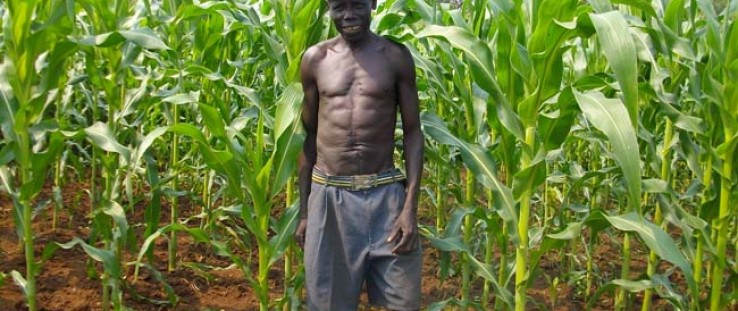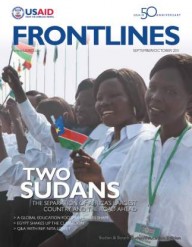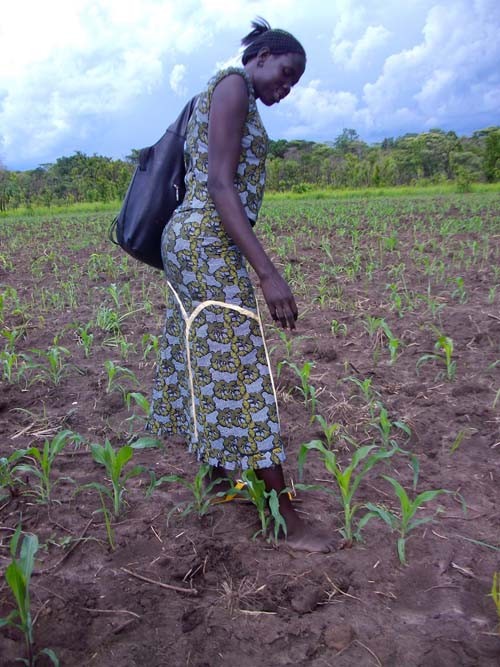 Farmer James Sworo with the maize he planted two months earlier in Kajo Keji County, South Sudan
Redento Tombe
Farmer James Sworo with the maize he planted two months earlier in Kajo Keji County, South Sudan
Redento Tombe
 Farmer James Sworo with the maize he planted two months earlier in Kajo Keji County, South Sudan
Redento Tombe
Farmer James Sworo with the maize he planted two months earlier in Kajo Keji County, South Sudan
Redento Tombe
Despite South Sudan’s severe poverty, lack of infrastructure, almost total economic reliance on the oil sector, and a nearly complete absence of private sector employment, the new nation has a very important and promising asset—vast amounts of uncultivated, arable land with excellent potential for agricultural productivity.
Though larger in land mass than France, only 4 percent of South Sudan is currently being cultivated, according to Anne Itto, South Sudan’s caretaker minister of agriculture and forestry.
Agricultural yield per hectare for cereals (maize, sorghum, millet, and rice) averages only approximately 0.5 metric tons in South Sudan. In comparison, the average yield in Africa is more than 1 ton per hectare, and more than 2.3 tons per hectare in South Africa and South Asia.
By improving productivity and expanding the area under cultivation, the new government aims to raise annual staple-food crop production from 700,000 metric tons to more than 1 million metric tons by 2013, which would enable South Sudan to reach near self-sufficiency. Neighboring Uganda produced 1.3 million metric tons of maize and 0.5 million metric tons of sorghum in 2009.
Both the South Sudan Government and USAID see agriculture as one of the keys to diversifying South Sudan’s economy, raising household incomes, and improving food security. And the agriculture sector is one of the Agency’s priorities for investment and collaboration with the South Sudanese, other donors, and the private sector.
“Agriculture will increasingly be a focus of USAID assistance to South Sudan going forward,” said USAID/South Sudan Mission Director Kevin Mullally. “The potential is great for this assistance to transform South Sudan’s economy and bring many people out of poverty because South Sudan remains an agrarian society, with the vast majority of the population engaged in agriculture to some extent.”
What’s more, he says, is that agriculture assistance can ensure a sustainable domestic food supply, reducing the need for expensive imports and international aid.
Untapped Potential
Approximately 85 percent of South Sudanese rely on agriculture for their livelihood, yet almost all are subsistence farmers. Hence, much of the food found in South Sudan’s urban markets is imported from Uganda, Kenya, and other countries, resulting in higher food prices for the population. In the last three years, South Sudan imports of agricultural produce averaged 700 million Sudanese pounds (approximately $262 million), half of which was fresh vegetables that could be grown locally.
The agriculture sector’s potential has not been fully harnessed for several reasons.
Farmers often had to flee their homes during the nearly quarter century of fighting, so traditional farming knowledge that would have been passed down to the next generation was lost. Moreover, large-scale or commercial farming never took root.
The 2005 Comprehensive Peace Agreement that officially ended the war between northern and southern Sudan brought more than 2 million South Sudanese refugees home, but uncertainty about security and the investment climate continued to hamper investment in agriculture. Additionally, the vast majority of South Sudanese farmers who are growing only enough food for their own families lack quality seeds and tools and have limited knowledge about farming techniques, irrigation methods, and how to reduce post-harvest losses.
Revitalizing South Sudan's Breadbasket
In May 2010, USAID launched a program to revitalize South Sudan’s “greenbelt” zone of the three Equatoria states—Western, Central, and Eastern Equatoria. These states have high agriculture potential with two reliable rainy seasons and fertile soil.
“The goals of the program,” said David Gosney, USAID/South Sudan’s economic growth team leader, “are to begin laying the groundwork for a transformation in agricultural practices. Current practices are extremely rudimentary. Many farmers do not even have access to an ox plow, and very few have any experience with quality seeds, soil fertility practices, or pest management. This is due in part to a near-complete lack of a functional agricultural private sector.
“We therefore hope to first introduce the concept of utilizing commercial farming inputs, then work to facilitate the establishment of seed companies, agro-dealers, commercial famer-based organizations, and consolidators who can both provide inputs to improve productivity and serve as extension agents.”
To do so, the program is training farmers and working with farmer associations and agriculture extension officers. In addition, in February 2011, USAID distributed 75 metric tons of improved maize and sorghum seeds to 132 of these farmers’ groups, benefiting 19,000 people.
“This is just the first small step in a much broader program that we hope will help address issues ranging from key policy reform, development of needed research and human capacity, establishment of agribusiness, and outreach to farmers,” Gosney says.
USAID will help lay the platform for transforming the agriculture sector and increasing agricultural trade, which in turn should lead to higher rural incomes, improved food security, and better economic opportunities for the poor.
James Sworo, chairman of the Julu-kita farmer association in Kajo Keji, Central Equatoria state, participated in one of the USAID-funded training workshops. When he arrived, he was like most other South Sudanese farmers who traditionally plant numerous seeds—as many as 10 in each hole—due to their low germination rates. During the training workshop, however, Sworo learned the seeds from USAID were of higher quality. They also had been treated with insecticides and fungicides.
Sworo set aside half a feddan (0.42 hectares) to test the seeds and follow the instructions from the training. Two months later, the difference was clear—the maize planted from improved seeds was growing higher and healthier than in the other feddans. The results convinced Sworo to fully adopt the one-seed-per-hole rule next season.
“We can stop importing food from Uganda by increasing the food we produce,” Sworo said. “Then we can start selling food to them.”
Esther Dima Kidden, an agriculture extension officer in Yei County, Central Equatoria state, arrived at a USAID-sponsored training with a newborn baby on her back. Despite the responsibilities of motherhood, Kidden has become one of the most successful extension workers in the program. In the past year, she has worked with more than 300 farmers in her county, and has cultivated at least half a feddan with other farmers to help them practice the new techniques and best practices she teaches them.
Women-Centered Approach
Women are a particular focus of USAID’s agriculture efforts as they produce most of Africa’s food. “It is the smallholder farmers, most of whom are women, who will determine whether or not this effort succeeds,” USAID Administrator Rajiv Shah said during a visit to South Sudan in May.
USAID is promoting women’s livelihoods through training and the formation of women’s farmer organizations—there are now 10. USAID is also tracking how training is benefiting women.
But for smallholder farmers, including women, to improve their productivity and income, they need a commercial structure to link to.
In May, USAID, the Netherlands, the Alliance for a Green Revolution in Africa, and the International Fertilizer Development Center signed a communiqué agreeing to help develop South Sudan’s commercial agriculture sector in collaboration with the government.
Workshops have already been held to craft an outline for a national program to promote commercialization of agriculture and enhanced food security. Plans are in the works to launch a campaign to highlight agricultural opportunities for smallholder farmers and to roll out a voucher program to provide up to 200,000 farmers with high-yielding seeds and fertilizers.
A U.S.-South Sudan partnership in higher education will produce graduates trained in agriculture, support and develop knowledge through research and testing, and create a quality university-based outreach program that addresses South Sudan’s long-term agricultural and natural resource-management needs. Participating schools are the University of Juba, Virginia State University, Virginia Polytechnic Institute and State University (Virginia Tech), and Catholic University of Sudan.
“Higher education in agriculture in South Sudan is experiencing tremendous challenges, including lack of equipment and laboratories for soil and water sciences, lack of qualified instructors, and no collaborative research with international and regional partner institutions,” said Ambassador R. Barrie Walkley, the U.S. consul general in South Sudan. “We must all work together to help address some of these issues, including post-conflict reconstruction and development.”
USAID is also working with Citibank, the International Finance Corporation, the Corporate Council on Africa, and others to help the new nation market and attract private capital and investors in key sectors, including agriculture. The Agency will partner with the World Bank, African Development Bank, European Union, and Japan to organize sector-specific private investor conferences, including one on agriculture.
“Developing a vibrant agriculture industry in South Sudan is critical to moving this war-decimated country down the path toward recovery and, eventually, prosperity,” said David Hughes, chief of party of the USAID-funded Food, Agribusiness, and Rural Markets (FARM) Project. “Agricultural revitalization does not entail any single project, but encompasses everything from building farming skills, to securing high-quality tools and materials, to working with the private sector to develop markets, to cultivating a knowledge base and infrastructure to ensure that progress is sustained.”










Comment
Make a general inquiry or suggest an improvement.